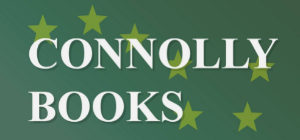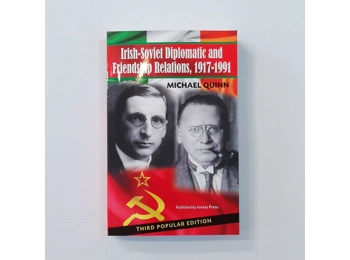Irish-Soviet Diplomatic and Friendship Relations, 1917-1991, by Michael Quinn
Product Code: 9780995597518
Rating: Be the first to write a review
Weight: 573.0g
Product Condition: New
The new front cover features photos of Éamon de Valera, President of the Executive Council of Dáil Éireann, and Maxim Litvinov, the Soviet People's Commissar for Foreign Affairs. They both attended the meeting of the League of Nations in Geneva in 1934, where Ireland voted in favour of the USSR's application to join the League.
The back cover photo of Angela McQuillan was taken when she was being interviewed by Moscow Radio during the visit of Noel Browne to the USSR in March 1988. Angela, who died in 2020, was the last Secretary of the Ireland-USSR Society, 1985-1992. When I was researching for my thesis and this book Angela kindly welcome me into her home in Bray and gave me a number of interviews and generous access to the records of the Society that she had carefully kept in her attic.
Also new to this edition is an image of the painting by the Dublin artist Eileen Gallen, which depicts the meeting in Paris in 1929 between the Irish writer James Joyce and the Russian filmmaker Sergei Eisenstein. Eileen's interest in the subject was sparked by the account of the reception of James Joyce’s writings in the USSR contained in this book (pp 242-4).
Otherwise, the content of the book remains as in the first two editions. It detail the state-to-state relations that were conducted between Ireland and the Soviet Union, which were led on the Irish side by Eamon de Valera and Dr Garret FitzGerald. It also catalogues the myriad friendship, trade union, political, academic, cultural and trade interconnections that were formed by Irish and Soviet citizens throughout the short Soviet twentieth century.
*******
The book is divided into two parts. The first deals with Irish-Soviet diplomatic affairs starting from the earliest contacts, even before the Irish Free State was established in 1922. The second part is devoted to Irish political and cultural relations, both North and South, with different parts of the Soviet system and the Communist Party. There is an extensive description of Irish-Soviet contacts and exchanges at both the League of Nations and the United Nations, covering in particular the periods from 1934 to 1939, which saw the effective collapse of the League of Nations.
Ireland was not a founding member of the United Nations in 1946. The Soviet Union vetoed our admission on the grounds that Ireland had been neutral during the second World War. We were not alone. It was not until 1955 that the impasse was resolved and 15 new member states were admitted, including Ireland. Frederick Boland was the first Irish Permanent Representative in the UN. He had a very impressive diplomatic career and was ultimately elected as President of the General Assembly. This was considered a particular honour for himself but also for Ireland.
Liam Cosgrave, as minister for foreign affairs, was Ireland’s first politician to address the United Nations General Assembly. He was followed by Frank Aiken, who succeeded him in 1957 when de Valera was re-elected taoiseach. The book describes, in considerable detail, how Aiken became a serious player in the United Nations. He was aided by Boland and his officials, including Conor Cruise O’Brien. This was the time of serious Cold War rivalry, particularly between the US and the USSR.
The Chinese permanent seat on the Security Council was at that time held by Formosa, now known as Taiwan, despite having lost the civil war to the communists. The People’s Republic of China claimed to be the rightful occupants but were blocked by the US and her allies. Irish government policy, up to then, supported the American position. So when Aiken voted against the US there was uproar at home in the Dáil but also in America, particularly with the Catholic Church.
*******
Michael Quinn was a member of the Connolly Youth Movement in the 1970s and founding chair of Maynooth Local History Group. He is chair of the James Connolly Memorial Initiative that commissioned the memorial to James Connolly, which stands in Beresford Place, opposite Liberty Hall, in Dublin's city centre.
In 2014 Michael was awarded a PhD at the Department of History, Maynooth University, for his thesis on the subject of Irish-Soviet diplomatic and friendship relations. This book is an adaption and expansion of that thesis for general readers.
This groundbreaking contribution to modern Irish history writing provides a detailed, and first ever, account of the state-to-state relations that existed between Ireland and the Soviet Union, and non-governmental friendship contacts that took place during the short Soviet twentieth-century.
The back cover photo of Angela McQuillan was taken when she was being interviewed by Moscow Radio during the visit of Noel Browne to the USSR in March 1988. Angela, who died in 2020, was the last Secretary of the Ireland-USSR Society, 1985-1992. When I was researching for my thesis and this book Angela kindly welcome me into her home in Bray and gave me a number of interviews and generous access to the records of the Society that she had carefully kept in her attic.
Also new to this edition is an image of the painting by the Dublin artist Eileen Gallen, which depicts the meeting in Paris in 1929 between the Irish writer James Joyce and the Russian filmmaker Sergei Eisenstein. Eileen's interest in the subject was sparked by the account of the reception of James Joyce’s writings in the USSR contained in this book (pp 242-4).
Otherwise, the content of the book remains as in the first two editions. It detail the state-to-state relations that were conducted between Ireland and the Soviet Union, which were led on the Irish side by Eamon de Valera and Dr Garret FitzGerald. It also catalogues the myriad friendship, trade union, political, academic, cultural and trade interconnections that were formed by Irish and Soviet citizens throughout the short Soviet twentieth century.
*******
The book is divided into two parts. The first deals with Irish-Soviet diplomatic affairs starting from the earliest contacts, even before the Irish Free State was established in 1922. The second part is devoted to Irish political and cultural relations, both North and South, with different parts of the Soviet system and the Communist Party. There is an extensive description of Irish-Soviet contacts and exchanges at both the League of Nations and the United Nations, covering in particular the periods from 1934 to 1939, which saw the effective collapse of the League of Nations.
Ireland was not a founding member of the United Nations in 1946. The Soviet Union vetoed our admission on the grounds that Ireland had been neutral during the second World War. We were not alone. It was not until 1955 that the impasse was resolved and 15 new member states were admitted, including Ireland. Frederick Boland was the first Irish Permanent Representative in the UN. He had a very impressive diplomatic career and was ultimately elected as President of the General Assembly. This was considered a particular honour for himself but also for Ireland.
Liam Cosgrave, as minister for foreign affairs, was Ireland’s first politician to address the United Nations General Assembly. He was followed by Frank Aiken, who succeeded him in 1957 when de Valera was re-elected taoiseach. The book describes, in considerable detail, how Aiken became a serious player in the United Nations. He was aided by Boland and his officials, including Conor Cruise O’Brien. This was the time of serious Cold War rivalry, particularly between the US and the USSR.
The Chinese permanent seat on the Security Council was at that time held by Formosa, now known as Taiwan, despite having lost the civil war to the communists. The People’s Republic of China claimed to be the rightful occupants but were blocked by the US and her allies. Irish government policy, up to then, supported the American position. So when Aiken voted against the US there was uproar at home in the Dáil but also in America, particularly with the Catholic Church.
*******
Michael Quinn was a member of the Connolly Youth Movement in the 1970s and founding chair of Maynooth Local History Group. He is chair of the James Connolly Memorial Initiative that commissioned the memorial to James Connolly, which stands in Beresford Place, opposite Liberty Hall, in Dublin's city centre.
In 2014 Michael was awarded a PhD at the Department of History, Maynooth University, for his thesis on the subject of Irish-Soviet diplomatic and friendship relations. This book is an adaption and expansion of that thesis for general readers.
This groundbreaking contribution to modern Irish history writing provides a detailed, and first ever, account of the state-to-state relations that existed between Ireland and the Soviet Union, and non-governmental friendship contacts that took place during the short Soviet twentieth-century.
€25.00 inc. tax
Customer Reviews
No Reviews Posted Yet - be the first! (write review)
















